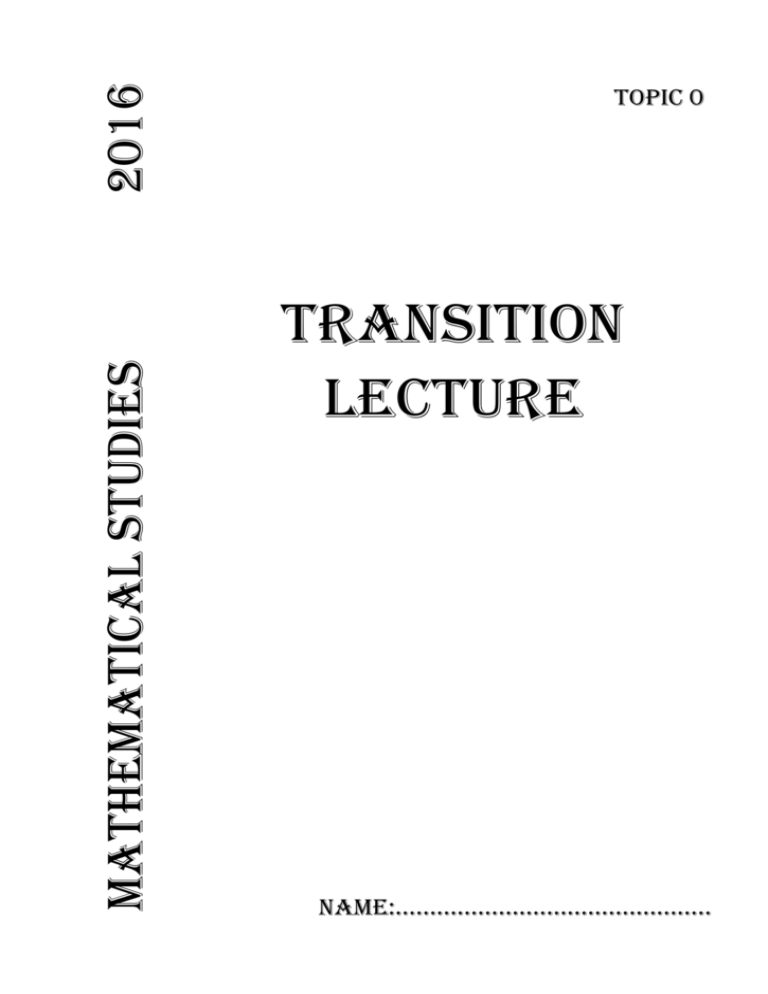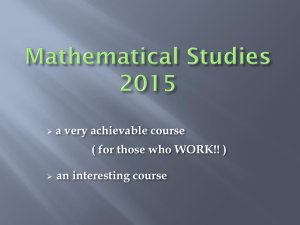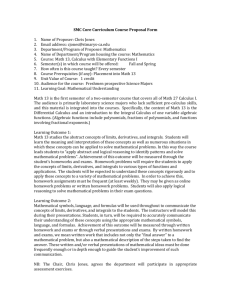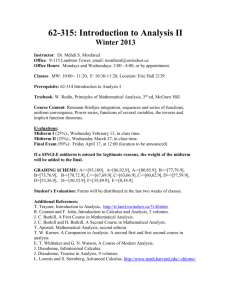Maths Studies Booklet
advertisement

2016 mathematical studies topic 0 Transition lecture name:………………….………….……….. Important Symbols, Terms, Phrases & Concepts Differential Calculus Change 0 0 Limit Chord (Secant) Slope of Chord Average Rate of Change Tangent Slope of Tangent Instantaneous Rate of Change Conjecture Proof Derivative Transition Lecture 1 Introduction to Mathematical Studies Mathematical Studies is: ____________________________________ ( ___________________________!!) _______________________________ Success is in your control! Keys to Success ___________________________ _____________________________ ___________________________ _____________________________ __________________________________________________________________ Text Books Mathematics for Year 12: Mathematical Studies 2nd Edition Year 12 Mathematical Studies Haese et. al. Study and Revision Guide (2015 or 2016) MASA (orders for the 2016 Guide will be taken in an early lecture next year) Graphics Calculator You will need a graphics calculator, which must be on the list of SACE Board approved calculators. This list can be found on the SACE website: www.sace.sa.edu.au From the home page follow the links: Learning, Subject List, Stage 2 Mathematical Studies, Approved Calculators Suggested Stationery 96 page A4 5mm Graph Book(s) (Note: All tests and exams are done on 5mm Graph Paper, it is a good idea to get used to working on this style paper.) A4 5mm Graph Test Pad Let’s see how a Maths Studies Lecture is structured!! Transition Lecture 2 An Introduction to Calculus The development of calculus started with two questions: 1. How do you find the _______ of shapes with __________________________? , and 2. How do you study __________ at an ________________________ ? It took almost ____________ for these questions to be answered formally. Studying Change at an Instant of Time Differential Calculus is the mathematics of ___________ and in a _________________________ world is one of the most widely used branches of mathematics. But the fact that caused so much concern was that _________________________________ which takes place ___________________________ gives us the expression , which is ________________________. The development of calculus required the idea of a ____________. Consider the slope of the ________________ and the slope of the _________________________. We can see that as ____________________________ , the approaches the We could write, Slope of Tangent The Slope of a Chord tells us ________________________________________________________. The Slope of a Tangent tells us _______________________________________________________. Transition Lecture 3 Example Consider the curve f ( x) x x x , where x 0 . Let A x, f ( x) be any point on the graph of y f (x) and let B be the fixed point 3, f (3) . The graph of y f (x) and the chord AB are shown below: a) The chord AB could be used as an initial estimate of the slope of the tangent to the curve y f (x) at the point B. Draw a second chord that would be a better approximation to the slope of the tangent to the curve y f (x) at the point B. b) Complete the following table, giving the slopes in the fifth column accurately to two decimal places. Point A x-coordinate y-coordinate Point B x-coordinate y-coordinate 2.5 3 2.9 3 2.99 3 Transition Lecture Slope of chord AB 4 c) Use your table to make a conjecture about the slope of the tangent at point B. In general, consider the curve _________. Using limits to find the slope of the _______________ at _________ gives This result could be used to prove our conjecture. Transition Lecture 5 Notes Transition Lecture 6 SACE Stage Two — Mathematical Studies Program and Assessment Plan 2016 Texts: Mathematics for Year 12: Mathematical Studies Study and Revision Guide Term 1 2nd Edition 2015 or 2016 Working with Functions and Function Models Haese et. al. MASA Chapter 1 & 5 The idea of a mathematical model and thus a functional model—Summary of the functional models of the course and their features—Properties of a good functional model—Working with the lower order polynomials—Graphing functional models— Simultaneous solutions of two functional models or a functional model and a relational model Matrix Arithmetic and Algebra Chapter 10 Definition of a matrix—Matrix arithmetic—Matrix algebra—The inverse and determinants of 2 2 and 3 3 matrices—Applications. Introductory Calculus Chapters 2 & 3 Areas with curved boundaries—Definite integrals—Average rate of change— Instantaneous rate of change—Idea of a limit—Derivatives at particular values and the derivative function, from first principles—Integral of a rate Term 1/2 Differential Calculus 1 Chapter 3, 4 & 5 Simple rules of differentiation—Composite functions and the chain rule—Product and quotient rules—Implicit differentiation—Tangents and normals—The second derivative— The derivative of the exponential function—The natural logarithm function—Derivatives of logarithmic functions—Motion in one-dimension Term 2 Differential Calculus 2 Chapter 4 & 5 Properties of curves—Rational functions—Optimisation—Exponential growth and decay models—Surge models—Logistic growth models—Other models Transition Lecture 7 Term 2/3 Integral Calculus Chapter 6 Anti-differentiation—Properties of indefinite integrals—Integration rules—Review of the definite integral—The area function—The fundamental theorem of calculus—Distance from non-constant velocity—Definite integrals—Finding areas—Integrals of rates— Simple differential equations Term 3 Probability Distributions Chapter 7 & 8 Probability distributions—Discrete & continuous random variables—The binomial distribution—The Normal distribution. Inferential Statistics Chapter 7 & 8 Sampling distributions—The central limit theorem—Confidence intervals for a population mean & a population proportion—Hypothesis testing of a population mean & a population proportion, using the two-tailed Z-test. Systems of Equations Chapter 9 Verifying solutions—Solving 2 2 systems of equations— 3 3 systems with unique solutions— 2 3 and other 3 3 systems—Parametric solutions—Further applications— larger systems Revision Term 4 Revision External 3-hour Examination Transition Lecture 8 Year 12 Mathematical Studies Assessment Outline The SACE Board requires each student to be allocated a score for Skills and Applications Tasks (i.e. Tests) and a Portfolio ( i.e. Investigations). Students also sit an External 3-hour Examination. Tests Testing will be done on a topic basis and, in general, each test will carry an equal weighting. As the year progresses, tests may contain a question from an earlier topic to give students other opportunities to demonstrate their learning and to assist with revision. Test Functions used a Mathematical Models Matrix Arithmetic and Algebra Introductory Calculus Differential Calculus 1 Differential Calculus 2 Mid-Year Exam Integral Calculus Probability Distributions Inferential Statistics Systems of Equations Term 1 1 1 2 2 3 3 3 3 4 Test Conditions Testing will usually be done during the tutorials under conditions that model the final examination. All tests will be prepared in booklet form with graph space provided for your answers. Appropriate steps of logic and correct answers are required for full marks. In each test you are allowed to have a single-sided A4 page of notes. These notes are to be an original copy, in your own handwriting. You are not allowed to bring in any other paper. You are also allowed to have two calculators from the approved SACE Board list. At the end of the test you will be requested to submit the question/answer booklet, your page of notes and any scribble paper used during the test. No material pertaining to the test is to leave the room and you are not to discuss the test with students outside your tutorial group. A Medical Certificate is required for an absence from a test and it is the responsibility of the student to present this to the teacher and organise an alternative time for the test. This is expected to be done on the students next day at school. Transition Lecture 9 Portfolio This will be made up of 2 Investigations. Investigations involve the concepts of mathematical investigation, formation of conjecture and proof (or refutation). Students will also need to write introductions, methodologies, conclusions and discussions. Investigations may have components which are done under ‘test’ conditions, while others would be ‘take-home’. Investigations will start by being quite directed and move towards being open-ended. Weightings A final score will be calculated as follows: Skills and Applications Tasks Portfolio Tasks External Exam 45% 25% 30% The school assessed components, Skills and Applications Tasks and the Portfolio are subject to a moderation process. Andrew Bee & Lisa Lanchester Transition Lecture 10 A suggested process to follow for the lecture/tutorial system in Maths Studies PREVIEW the next few pages of the lecture booklet LECTURE LECTURE REVIEW SUMMARISE THE LECTURE Familiarise yourself with the _______________ to be used. Presentation of: ____________, and _________________________________ _________ the lecture ______ about the parts that are _____________ Focus on: _____________________ , ________________ and _______________ _____________________ _______________ , __________ and ________________________ Come and _____________ your summary. DO THE PRACTICE PROBLEMS from the textbook &/or worksheets STAY ___________________!! do some maths ___________________ _____ questions ____________ and __________ _____________________! PREPARE FOR THE TOPIC TEST prepare your ________ of notes learn the _____________ and ________ ____________, ____________, _____________






